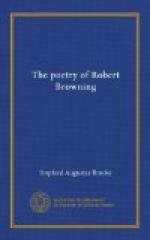As usual, Spring enchants him. The second book begins with her coming, and predicates the coming change in Sordello’s soul.
The woods were long austere
with snow; at last
Pink leaflets budded on the
beech, and fast
Larches, scattered through
pine-tree solitudes,
Brightened, as in the slumbrous
heart of the woods
Our buried year, a witch,
grew young again
To placid incantations, and
that stain
About were from her cauldron,
green smoke blent
With those black pines.
Nor does he omit in Sordello to recall two other favourite aspects of nature, long since recorded in Pauline, the ravine and the woodland spring. Just as Turner repeated in many pictures of the same place what he had first observed in it, so Browning recalled in various poems the first impressions of his youth. He had a curious love for a ravine with overhanging trees and a thin thread of water, looping itself round rocks. It occurs in the Fireside, it is taken up in his later poems, and up such a ravine Sordello climbs among the pines of Goito:
He climbed with (June at deep)
some close ravine
Mid clatter of its million
pebbles sheen,
Over which, singing soft,
the runnel slipped
Elate with rains.
Then, in Sordello, we come again across the fountain in the grove he draws in Pauline, now greatly improved in clearness and word-brightness—a real vision. Fate has given him here a fount
Of pure loquacious pearl,
the soft tree-tent
Guards, with its face of reate
and sedge, nor fail
The silver globules and gold-sparkling
grail
At bottom—
where the impulse of the water sends up the sand in a cone—a solitary loveliness of Nature that Coleridge and Tennyson have both drawn with a finer pencil than Browning. The other examples of natural description in Sordello, as well as those in Balaustion I shall reserve till I speak of those poems. As to the dramas, they are wholly employed with humanity. In them man’s soul has so overmastered Browning that they are scarcely diversified half a dozen times by any illustrations derived from Nature.
We now come, with The Ring and the Book, to a clear division in his poetry of Nature. From this time forth Nature decays in his verse. Man masters it and drives it out. In The Ring and the Book, huge as it is, Nature rarely intrudes; the human passion of the matter is so great that it swallows up all Browning’s interest. There is a little forky flashing description of the entrance to the Val d’Ema in Guido’s first statement. Caponsacchi is too intensely gathered round the tragedy to use a single illustration from Nature. The only person who does use illustrations from Nature is the only one who is by age, by his life, by the apartness of his high place, capable of sufficient quiet and contemplation to think of Nature at all. This is the Pope.




